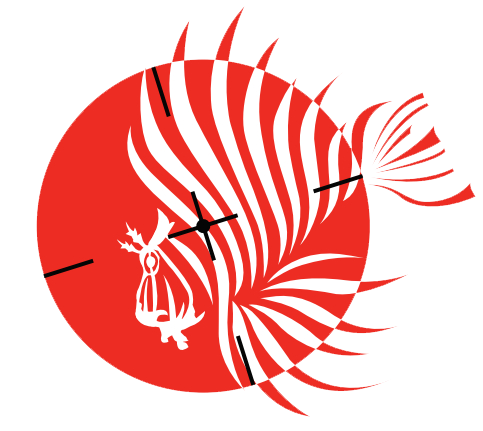Everything you ever wanted to know about filleting, cleaning, gutting, scaling and preparing lionfish but were afraid to ask:
First and foremost, the most important information you need when it comes to handling lionfish is to know where all of the venomous spines are located… keep in mind, there are generally 18 spines that can be sharper than a hypodermic needle; 13 of them are located along the spine in the dorsal fins, there is one short spine in the leading edge of each of the pelvic fins and 3 short spines in the leading edge of the anal fin.
Suggested tools:
 Puncture-proof Gloves, like Hex Armor gloves – I don’t wear them but I know people who won’t handle lionfish without them.
Puncture-proof Gloves, like Hex Armor gloves – I don’t wear them but I know people who won’t handle lionfish without them.- Long Barbecue / Meat Tongs – I routinely use them for handling lionfish, especially for removing them from the pile in my ice chest.
- Very Sharp Fillet Knife – A sharp knife with a thin, flexible blade means less pressure will be applied to the lionfish and less movement will occur while handling during the filleting process thus lessening the chances you might get stuck by a spine.
- Kitchen Scissors or Trauma Shears, like these shears, the kind paramedics use that have an angled blade and long handles – they’ll cut through anything!
- Large Cutting Board – I prefer a wooden cutting board because they tend to be less slippery as I am preparing a lot of lionfish.
- An Outside Workspace – Because cleaning and gutting lionfish can get messy!
- Lots of water – Water keeps everything clean and easy to work through.
Perhaps not the best acting in the bunch, the video very admirably demonstrates where the lionfish’s venomous spines are located and covers the most basic technique that most novice cooks will use to render the lionfish safe to handle – cutting away the dangerous spines with kitchen shears. This is Lionfish Preparation 101 and deserves to be at the top of our list:
Other than referring to lionfish as poisonous rather than venomous and mistakenly referring to the pelvic fins as pectoral fins, the Guy Harvey team does a great job demonstrating how to handle the lionfish then do the initial filet and removing the skin. They discuss a few ways to prepare the lionfish as well.
The following is a video demonstration by Lad Akins, the Special Projects Director working with lionfish at REEF. He’s obviously a veteran in handling and preparing lionfish. He says his favorite way to prepare lionfish is in a ceviche. The method he demonstrates to safely handle and fillet a lionfish begins with peeling the skin off first, then filleting the rest of the fish. Lad’s suggestion is to always lay the fish flat on the cutting surface so that the venomous spines lay flat and are less of a danger of causing injury. The video ends with Lad frying up some lionfish nuggets and a tip from his assistant how to denature the lionfish spines’ venom then use them as cocktail toothpicks.
The following video takes a bit of a different approach by first cutting off all of the venomous spines and getting them all out of the way first.
While the video quality is pretty bad in this video, it is my personal favorite way of filleting lionfish because the lionfish is essentially filleted and skinned using one cutting motion. Handling and close contact with the spines are kept to an absolute minimum. One hand is used to put a barbecue fork through the head and into the cutting surface, which holds the lionfish firmly in place, and the other hand uses the fillet knife. This makes very quick work when cleaning a ton of lionfish. Check it out:
Lastly, the following video, produced by Gerardo Ochoa, is perhaps one of my favorite. Great discussion and demonstration. In his words, “This is not rocket science.”He cuts away the spines first, checks the contents of their stomachs then guts the lionfish. BEST OF ALL – Gerardo prepares a beautiful and simple whole garlic lionfish in the microwave for the rest of us to salivate over! Bonus points for making a wine suggestion!!! Bon Appetite, indeed:
What would you add to these very different techniques to fillet, clean and prepare lionfish for cooking or eating any way you might like? Do you have a specific technique or way you like to get your lionfish ready? Tell us in the comments below or drop us the URL to your favorite video.
Interested in getting hands on lionfish handling and hunting training from the experts? Check with the non-profit group Ennds.org to find out about their next lionfish training dive.




Hi Scott, thank you very much for this website. It is enlightening.
I’m from California and steam whole fish Cantonese style is a popular way to eat any fresh fish. It basically steam the fish high heat for ~ 12 minutes, drained, put on shredded green onion, add soy sauce, then lastly pour on hot oil (higher boiling point oil like frying oil, but probably not olive oil due to its low boiling point).
I wonder if anybody has tried this style? What happen if one got stung by the spine? Any established method to relief the pain ( I assumed)?
Thank you very much.
David
Growing up in S. California I ate fish prepared like that quite a bit with my best friend’s family though I’m not aware of anyone having prepared lionfish that way (yet)! We do fry them whole (gutted), but that’s not the same. Thanks for the idea and I will do this in the next few days and post a video. The steam and hot oil MIGHT denature the venom but I wouldn’t take the chance. I’d clip the dorsal spines to about 1/2 from the spine for presentation (and safety) then get rid of the others (anal and pelvic) altogether.
We’ve posted an excellent first aid and treatment article at https://lionfish.co/sting-first-aid/
Again, thanks for your idea!
– Scott
Thank you for the article. Where can I purchase some of these fish to eat? I’m located in Southern California near Los Angeles. Thanks for any information.
Can you eat the skin? Or does it contain levels of ciguatoxin?
IF (and that is a very RARE if) a lionfish had dangerous levels of ciguatoxins, they would be in the flesh, organs and muscles of the fish.
Ciguatoxin is in reference to Ciguatera , which is a totally irrelevant issue than the venom from Lionfish. You can find the definition easily online . The fish uses the spines defensively for larger predators. You can leave the skin on when cooking, it has nothing harmful. Like cooking other fish, I don’t hink you will enjoy the taste of the skin ….. It peels off easily …..
A very useful article – we should all be eating them right now.
Lionfish is on the menu at several restaurants in Bocas del Toro in Panama.
Any fish caught during our fishing or scuba charters will be turned into a feast by our chef.
Don’t forget to use proper disposal techniques for the spines that you cut off. A plastic biohazard container from any drug store works well. You can also throw them in a firepit.
In one video, the filleted, ungutted body is tossed back in the ocean. Although I think this is far and away the best way to give something back to the ocean, I had to wonder if the toxins in the carcass could cause any issues when it is being decomposed by other creatures. Any Insight?